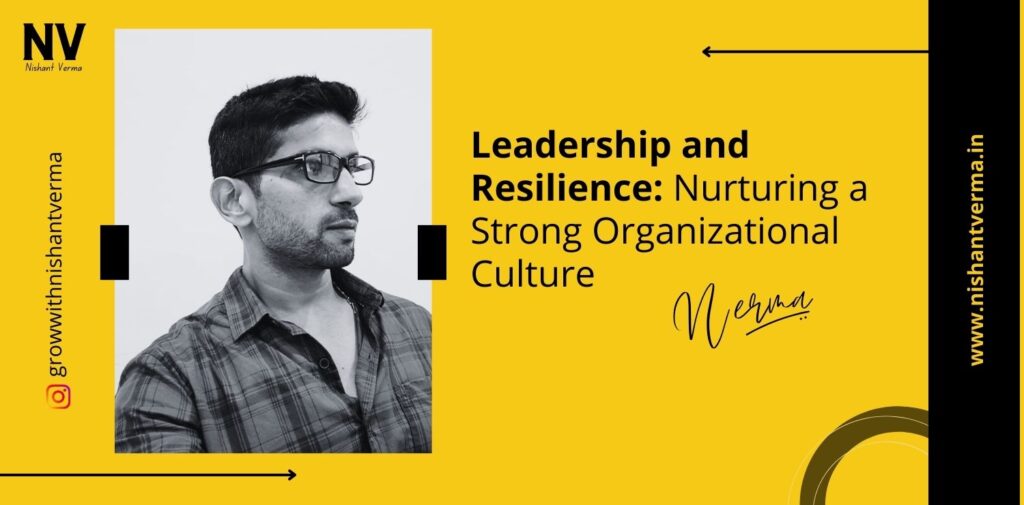Leadership and resilience is more than steering the ship; it’s about building a culture that weathers any storm. In this article, we’ll explore the vital connection between leadership and building a resilient organizational culture, breaking down what it means, why it’s crucial, and how leaders can foster an environment that stands strong in the face of challenges, making their organization an unwavering force.

Understanding Resilient Organizational Culture:
What is Resilient Organizational Culture?
Resilient organizational culture is like the ship’s sturdy hull. It’s the collective mindset, values, and behaviours that enable a company to bounce back from setbacks, adapt to change, and thrive in challenging times. It’s like having a ship that not only survives storms but emerges even stronger.
The Role of Leadership:
Leaders are like the architects of the ship. They shape the culture by setting the tone, guiding the crew, and instilling the role of leadership and resilience in the organization. If leaders focus on building a resilient organizational culture, they become the builders of a ship that can navigate any sea.
Elements of Resilient Organizational Culture – Leadership and ResilIence
Open Communication:
Open communication is like a well-functioning navigation system. Leaders foster an environment where team members feel comfortable sharing ideas, concerns, and feedback. It’s like having a crew that openly communicates to navigate through challenges.
Adaptability:
Adaptability is like adjusting the sails to changing winds. Leaders encourage flexibility and a willingness to embrace change, ensuring the organization can navigate through unpredictable waters. It’s like having a crew that can swiftly adjust to new conditions.
Employee Well-Being:
Employee well-being is like ensuring the crew’s health and morale. Leaders prioritize the physical and mental health of team members, creating an environment where everyone feels supported and valued. It’s like having a crew that is physically and mentally fit for the journey.
Learning Culture:
A learning culture is like continuously upgrading the ship’s equipment. Leaders promote a culture of ongoing learning and development, ensuring the organization remains up-to-date with the latest tools and skills. It’s like having a crew that is always improving their abilities.
Why Building a Resilient Organizational Culture Matters:
Navigate Uncertainty:
Building a resilient organizational culture helps navigate uncertainty. When the culture values adaptability, the organization can face unexpected challenges with a sense of preparedness. It’s like having a ship that confidently sails through unpredictable seas.
Retains Top Talent:
A resilient culture retains top talent. When employees see that the organization supports their well-being and growth, they are more likely to stay on board. It’s like having a crew that is committed to the long journey.
Enhances Problem-Solving:
A resilient culture enhances problem-solving. When the organization encourages open communication and learning, teams can collaboratively address and overcome obstacles. It’s like having a crew that collaborates effectively to navigate around obstacles.
Encourages Innovation:
A resilient culture encourages innovation. When leaders foster an environment that embraces change, employees feel empowered to suggest and implement new ideas. It’s like having a crew that actively contributes to charting innovative courses.

Fostering a Resilient Organizational Culture: Strategies for Leaders:
Lead by Example:
Leading by example is like steering the ship with confidence. Leaders demonstrate resilience in their Leadership and resilience in their actions and decisions, setting a standard for the entire organization. It’s like a captain who remains calm and composed during turbulent times.
Communicate Transparently:
Communicating transparently is like having clear navigation instructions. Leaders share information openly, ensuring that the entire organization is aware of challenges and strategies for overcoming them. It’s like a captain who keeps the crew informed about the course ahead.
Encourage Continuous Learning:
Encouraging continuous learning is like having a crew that constantly upgrades their skills. Leaders invest in training and development opportunities, promoting a culture of ongoing learning. It’s like a captain who ensures the crew is well-prepared for any weather.
Prioritize Employee Well-Being:
Prioritizing employee well-being is like maintaining the crew’s health. Leaders provide resources and support for the physical and mental well-being of team members. It’s like a captain who ensures the crew is well-rested and in good spirits for the journey.
Celebrate Successes and Failures:
Celebrating successes and failures is like marking milestones on the ship’s map. Leaders acknowledge achievements and learnings, reinforcing a culture that values both success and Leadership and resilience in the face of setbacks. It’s like a captain who celebrates each successful leg of the journey.
Case Studies: Real-Life Examples of Leadership and Resilience Organizational Culture:
Toyota’s commitment Approach to Continuous Improvement:
Toyota’s commitment to continuous improvement, as seen in the Toyota Production System, is an example of building a resilient organizational culture. The company promotes a culture of learning, adaptability, and problem-solving, allowing them to thrive in the competitive automotive industry.
Zappos’ Emphasis on Company Culture:
Zappos’ emphasis on its unique company culture is an example of prioritizing employee well-being. The company focuses on creating a positive and supportive environment, encouraging innovation and adaptability.

Challenges and Solutions in Building a Resilient Organizational Culture:
Resistance to Change:
Leaders address resistance to change by communicating the benefits of Leadership and resilience, involving employees in the decision-making process, and providing support during transitions. It’s like convincing the crew that adjusting the sails is necessary for a smoother journey.
Balancing Workload:
Leaders Balancing workload by promoting work-life balance, distributing tasks effectively, and recognizing the importance of rest and recovery. It’s like ensuring the crew has adequate shifts and time for rest during the journey.
Conclusion:
In the vast sea of leadership, building a resilient organizational culture is the compass that guides the ship through both calm waters and storms. Fostering an environment of adaptability, learning, and well-being is not just a task; it’s the essence of creating an organization that stands tall in the face of challenges. By understanding the elements of Leadership and resilience, recognizing its significance, and implementing strategies to build a resilient organizational culture, leaders become the architects of a ship that can navigate any sea with a crew that is strong, united, and ready for the journey ahead. In essence, building a resilient organizational culture is not just about surviving; it’s about thriving and emerging even stronger in the ever-changing landscape of the business world.




